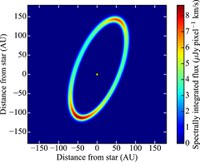Exocometary Gas
Recent ALMA observations present mounting evidence for the presence of exocometary gas released within Kuiper Belt analogs around nearby main-sequence stars. This represents a unique opportunity to study their ice reservoir at the younger ages when volatile delivery to planets is most likely to occur. Matrà et al. present the detection of CO J = 2-1 emission colocated with dust emission from the cometary belt in the 440 Myr old Fomalhaut system. Through spectrospatial filtering, they achieve a 5.4σ detection and determine that the ring's sky-projected rotation axis matches that of the star.
The derived CO mass (0.65-42 x 10-7 M⊕,) is the lowest of any circumstellar disk detected to date and must be of exocometary origin. Using a steady-state model, the authors estimate the CO + CO2 mass fraction of exocomets around Fomalhaut to be between 4.6% and 76%, consistent with Solar System comets and the two other belts known to host exocometary gas. This is the first indication of a similarity in cometary compositions across planetary systems that may be linked to their formation scenario and is consistent with direct interstellar medium inheritance. In addition, the authors find tentative evidence that 49 ± 27% of the detected flux originates from a region near the eccentric belt's pericenter. If confirmed, the latter may be explained through a recent impact event or CO pericenter glow due to exocometary release within a steady-state collisional cascade. In the latter scenario, Matrà et al. show how the azimuthal dependence of the CO release rate leads to asymmetries in gas observations of eccentric exocometary belts.
Image: Model image for the maximum CO J = 2-1 flux enhancement expected at pericenter with respect to apocenter through steady-state CO production in the Fomalhaut ring. The model predicts a flux density enhancement of ~14.5% at the pericenter with respect to the apocenter location.
Publication: L. Matrà (University of Cambridge) et al., Detection of Exocometary CO within the 440 Myr-old Fomalhaut Belt, 2017, Astrophysical Journal, 842, 9.





Connect with NRAO